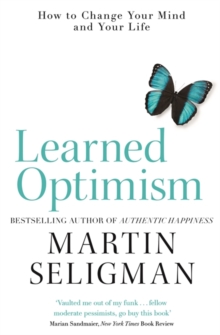Learned Optimism by Martin Seligman
Book about two things. First - memoir and a short history of positive psychology. Second - differences between pessimism and optimism. How helplessness and depression connect to them.
Polish title: "Optymizmu można się nauczyć"

What's good #
I enjoyed the first and last part of the book. In the first chapters, I've learned more about optimism, learned helplessness and pessimism. The last part of the book, on how to be optimistic. What techniques to use. When it makes sense to stick to pessimism.
What's boring #
Middle of the book is the story of the guy with a hammer who tries to solve all kinds of problems with optimism. Not convincing and pretty boring to read.
Did I like it? Kind of, but I'm not sure if it's worth recommending.
What I got from it? #
Your mood depends on what you say about things that happen to you - events themselves are neither good nor bad.
You can see even bad events from a time perspective as fortunate. For example, being fired if it lets you find your dream job.
There are 3 explanatory styles: #
- Permanence
- Pervasiveness
- Personalization
For me it's most useful to see it in a table with examples of thoughts you might have for each of them:
| Permanence | Pervasiveness | Personalization | |
|---|---|---|---|
| Pessimistic | Bad things like this one will always happen | I am a failure | It is my fault |
| Optimistic | I had bad luck this time | At least I'm good at sleeping ;) | It's not my fault |
Another way to look at it is:
| Good Situation | Bad Situation | |
|---|---|---|
| Optimist | Permanent, Pervasive, Personal | Temporary, Specific, External cause |
| Pessimist | Temporary, Specific, External cause | Permanent, Pervasive, Personal |
Mr. Seligman believes that some cases of depression are pessimism on steroids. In the book pessimistic and depressed people being more realistic. In other books, I've seen it's stressed that depressed people are far from realists. They struggle with mental distortions that keep them in the depressed state. Optimistic people do seem to have some distortions of their own but they make them feel better. Eg. they are above average (illusory superiority) and in control even when they're not.
See more about positive illusions at wikipedia
One striking example of optimistic behavior you can do more to feel better is blaming others. But, it's more common now to hear that you should take responsibility for what happens to you. I can't say anyone likes a person that always blames someone else.
Permanence and Pervasiveness make a lot more sense to me in general cases. At the end of the book, there is a couple of strategies to dispute those kinds of thoughts.
Disputation: #
- Do you have any facts to prove that thought?
- Is there any other way to explain what happened?
And my favorite:
- It doesn't matter if it's true, but is it helpful?
The other two are now standard in CBT list of disputations for cognitive distortions.
Question I didn't find an answer for: #
Mr. Seligman says that you can't fake your optimism score and wants to use it in job interviews. I'm not buying it because he says so and I couldn't find any proofs for it. I'm more likely to believe that knowing what the test is looking for would allow me to fake a response.
Other points of view #
A lot of new IT projects start with new planning technique called Pre-mortem. It is like the cognitive strategy of Defensive pessimism. The idea is to look into the future - imagine all that can go wrong and prevent all those things from happening. It makes a project safer and faster to deliver by moving the hard things to the frontline.
As you can read on Wikipedia Defensive pessimism makes you as much accomplished as optimism. The only drawback is that you won't feel as good as an optimist about it. That's not a big cost to me.
In real life, pessimism is not seen as that bad when used wisely. If it makes you a little less happy but pushes you to do things. Seligman argues that optimism would get you the same result with positive delusions. You can push harder when delusional. That's true. You can also do dumb things without taking the blame. Over and over again as you're optimistic about the end result.
Mr. Seligman advises using both optimism and pessimism but to pick one depending on the cost of failure in a given situation. If the cost is high - then pessimism is safer. The fun part is that optimism makes the most sense if the cost of failure is small. Asking for a rise. Striking a conversation. There is a lot of situations like that in life. As always the problem is seeing things clearly and deciding on a case by case basis what strategy to use.
Criticism: #
- Positive Psychology Is Garbage (And Why You Should Follow Its Founder's Lead)
- Stand Firm: Resisting the Self-Improvement Craze by Svend Brinkmann
- Bright-sided: How Positive Thinking Is Undermining America by Barbara Ehrenreich
What I suggest instead: #
- Feeling Good as it's even proven to help people in depression while it still has some drawbacks it's way better at helping you unlearn pessimism or fight depression.
Want to learn more?
Sign up to get a digest of my articles and interesting links via email every month.